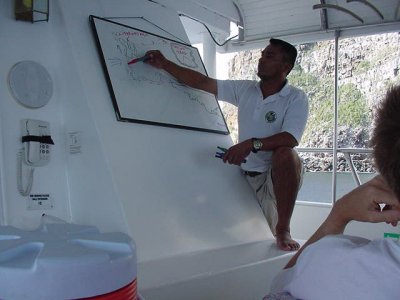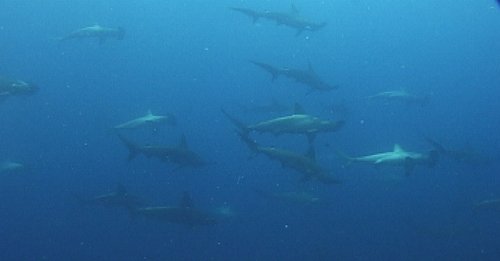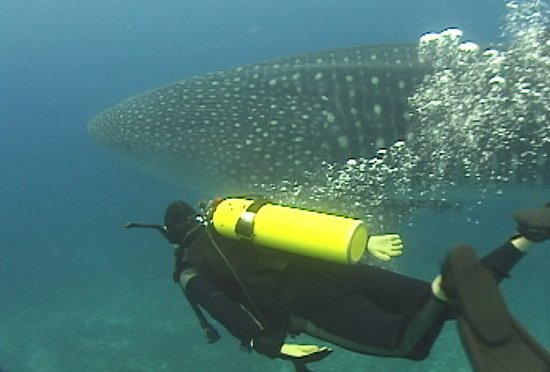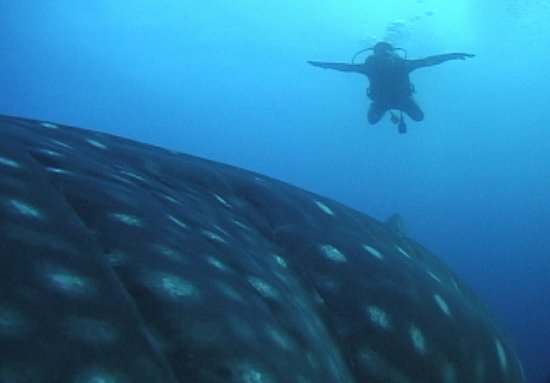|
Darwin, by far the most remote island in the chain and one that few liveaboards get to, promises the best chance at the underwater world the Galapagos are famous for - hammerhead sharks, Galapagos sharks, white-tip reef sharks, and of course, the real quarry, the whale shark, or “Mr. Big” as everyone in the dive world refers to it. Up to 65 feet long, it’s the biggest fish in the ocean but one of the rarest to actually encounter.
 Divemaster Victor gives the required briefing prior to every dive Divemaster Victor gives the required briefing prior to every dive
This is diving unlike any I’ve ever experienced previously. Visibility is less than Caribbean, but is expected as such. Water is relatively cold, about 68, but the cold water is filled with nutrients and plankton, which is the initial link of the astonishing food chain in these waters. On the panga after the first dive, returning to the Reina Sylvia, Victor gets excited and points out a large black cloud underneath us, asks if anyone wants to jump in for an impromptu dive. It was an enormous moving concentration of fish, an absolute cloud of brown-stripe salema, a mass of fish that was an essentially a solid, ellipsoidal object at least a hundred feet in diameter. Swimming underneath the school was practically a night dive, this mass completely blocked out the sun. And swimming through it was amazing, looking up, the fish would swim away from my ascending bubbles, leaving a vertical hole for the sun to shine through, and then they would close up quickly when the bubbles had gone past, and all would be solid fish and darkness again. We continued to swim through and around this mass of moving sushi as long as our air held out. Anyone with vertigo or claustrophobia would have had a tough time of it, as being totally enveloped by fish all around you, at only a few inches away, can be a little disorienting! The only way to definitively discern “up” from “down” is to watch your bubbles!


Hammerhead Sharks abound!
On land, we wander among throngs of marine iguanas sunning and spitting out the sea-salt they had ingested during their underwater algae-feeding. We also stroll through the ever-present boobies and cormorants; even a sea lion pup that Victor says was probably born that morning.
Darwin is the most remote island in the chain – it’s across a deep, channel of consistently high seas and is thus an island that few liveaboards get to. We are REALLY out in the middle of nowhere now, a tiny, tiny dot in the infinity that’s the Pacific Ocean.

Darwin's Arch welcomes us to an island few get to see!
But aside from an amazing concentration of hammerhead sharks, Galapagos sharks, and sea lions, it also offers the real quarry of the trip, the whale shark…,or “Mr. Big” as everyone in the dive world refers to it. Up to 65 feet long, it’s the biggest fish in the ocean but one of the rarest to actually find. Darwin is also legendary for absolutely devilish rip-currents and very high swells, making it highly likely for divers to surface some distance away from the panga, and making it very difficult for the pangas to spot divers once they’re on the surface. Good reasons why this trip is for advanced, experienced divers only. And the nautical trek paid off - we have FOUR whale shark sightings, including two on one dive! To swim along inches away from a fifty-foot behemoth is a rush that is truly difficult to put into words!
| Swimming furiously toward a giant, but still 30 feet away from him! |
 |

|